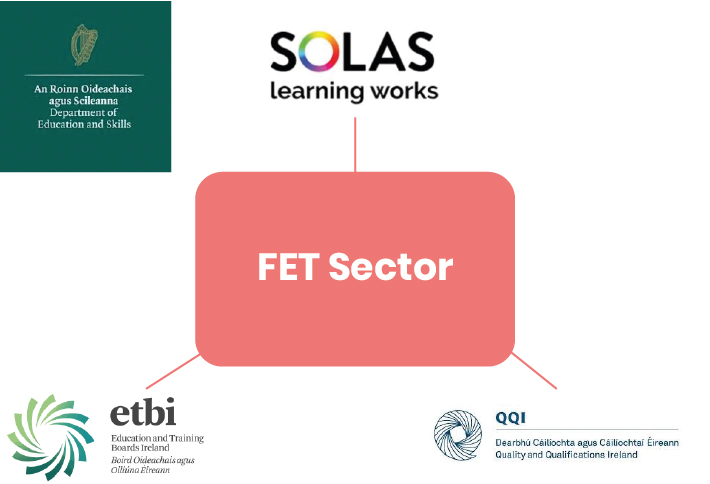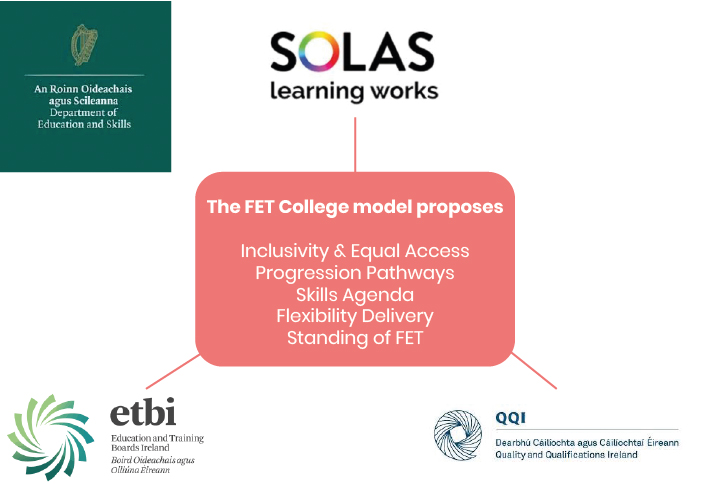

A fundamental prerequisite for successful implementation of national policy is to ensure there is sufficient local capacity to deliver. The FET college model, if developed, will re-engineer FET colleges so they can respond to the need of the Irish economy and wider society.
Further Education and Training (FET) reform began in 2010, when the Department of Education became the Department of Education and Skills (DES) through the transfer of skills training from the Department of Enterprise, Trade and Employment. This reform continued with the establishment of Quality and Qualifications Ireland (QQI) in 2012, the Further Education and Training Act in 2013, and the Education and Training Boards Act in 2013.
In May 2014, the first national FET Strategy was launched, which presented ‘a roadmap and implementation plan to realise the vision of a world-class integrated system of further education and training in Ireland’ (SOLAS, 2014, p. 3). The five years of the Strategy could be characterised as setting the strategic direction and structure of the FET sector in Ireland.
The FET reform agenda over the last five years has also invested considerable resources in building and developing the institutional triangle of SOLAS, QQI, and the Education and Training Boards (ETBs). The reform agenda has, for example:
Each reform agenda brought considerable strategic operational challenges, but when viewed holistically they strive to provide better FET outcomes in terms of quality experiences and value for money. Reform agendas have also firmly placed lifelong learning at the centre of this strategic transformation. Numerous research projects generated since 2012 have supported and confirmed that the strategic direction of FET in Ireland today is on track.

The institutional triangle that arose through the strategic legislative reform of the FET sector beginning in 2012.
It is well documented that the Irish FET landscape is broad and varied, providing a large range of programmes to a diverse student cohort, with varied terms and conditions. The SOLAS Further Education and Training Strategy 2014–2019 outlines five goals, and in the last five years the distance travelled towards achieving them has been substantial.
Educational reform has also been central to economic agendas, including the provision of labour-market activation measures enacted during and after the ‘troika years’, such as Ireland’s National Skills Strategy 2025 and the Action Plan for Jobs 2018.
While all of these reforms and publications set out a welcome intertwining roadmap for the development of Ireland’s economy and its citizens through education and training, Ireland now has an opportunity to develop and restructure its FET offering to ensure better-value outcomes for students and for the exchequer, regardless of the prevailing economic circumstances. One proposal is to develop an FET college model which seeks to:
These core elements are elaborated upon below.

The FET college proposition
The National Association of Principals and Deputy Principals’ (NAPD) vision document ‘Realising Opportunities: A Vision for Further Education and Training’ (2014) described how FET colleges were ideally placed to support the ETBs in meeting their expanded remit in providing education and training. It called for
the creation of a student-centred, statutorily mandated, strategically planned, responsive and dynamic college sector as a foundational pillar of a new and successful FET landscape and envisioned within this landscape where FE Colleges become ETB hubs and deliver a range of programmes on a year-round basis.
FET colleges could be resourced properly with adequate funding, equipment, staffing, and fit-for-purpose governance models. Students should be able to approach an FET college in their geographical area and enrol seamlessly onto an FET course that fits their needs, whether it is full-time or part-time.
[ctt template=”2″ link=”acn1d” via=”no” ]There is no consistent approach to student supports across the sector… There is a distinct lack of guidance and counselling supports.[/ctt]
Due to legacy structure and organisational systems, many ETBs keep education and training provision separate. Many FE colleges already offer a wide range of fields of learning to students across a broad range of programmes, for example PLC, traineeship, pre- and post-2016 apprenticeship, self-financing part-time, general learning, and in some cases degrees.
There is now an ideal opportunity to consolidate and build on the capacity of the existing FE colleges to provide first-class FET hubs to communities across Ireland. Rather than continuing with discrete pillars of provision, FE colleges could be used to integrate and build on the experiences of training provision, thus uniting the education and training sector and creating a better-value experience for students.
The core elements of the FET college model are listed below. I acknowledge that there are many other aspects to be considered, but based on my experience to date and my interaction with students over the past twenty-seven years, the items listed below are central to developing a world-class FET system.
For example, students should be able to attend any one of the twenty-six FET programmes on offer without having to navigate different sets of confusing eligibility rules. Funding should be provided for all FET programmes under standard guidelines that allow each student to receive a level of funding that is transferable between programmes.
[ctt template=”2″ link=”40efh” via=”no” ]Students should be able to approach an FET college in their geographical area and enrol seamlessly onto an FET course that fits their needs.[/ctt]
At present, the student support system is reactive and unsustainable. Of the twenty-six FET programmes funded by SOLAS, only students on the PLC course have access to the Fund for Students with Disabilities. There is no consistent approach to student supports across the sector. Literacy (including digital literacy), numeracy, and English language supports are in great demand. There is a distinct lack of guidance and counselling supports.
Develop and recognise that progression pathways can be non-linear. Not all students progress to third level from the Leaving Cert. At least 2,000 PLC students per year are recorded as having some form of HE experience.
Develop clear roadmaps for career and occupational progression that show how students can navigate from FET to HE with better retention outcomes.
A discussion about staffing resources and contracts needs to take place. Equally, it must be recognised that staff too may welcome these new arrangements, as they also have to manage work and family life in this new era.
A fundamental prerequisite for the successful implementation of national policy is to ensure there is sufficient local capacity to deliver. There is now an opportunity to re-engineer FET colleges so they can respond to the needs of the Irish economy and wider society. Currently, the FET colleges are dispersed across the country and based firmly in their communities. They are ideally placed to be a central part of the new integrated FET system in Ireland.
Looney (2019) proposed that the FET college could be a ‘beacon in, and for, the community’. I am strongly of the view that the current network of FET colleges, as part of the new FET colleges of the future, can be leveraged to become even greater beacons in their communities than they already are. This is worth considering.
Looney, A. (2019) Rapporteur’s Report. NAPD FET Symposium: Towards the FET College of the Future. Clontarf Castle Hotel, Dublin, Ireland, 2 April.
McGuinness, S., Bergin, A., Kelly, E., McCoy, S., Smyth, E., Watson, D., and Whelan, A. (2018) Evaluation of the PLC Programme Provision. Research Series Number 61. Dublin: ESRI.
NAPD (2014) Realising Opportunities: A Vision for Further Education and Training. Dublin: NAPD.
SOLAS (2014) Further Education and Training Strategy 2014–2019. Dublin: SOLAS.
Copyright © Education Matters ® | Website Design by Artvaark Design